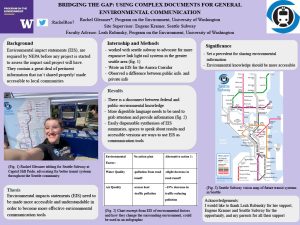Bridging the Gap: Using Complex Documents for General Environmental Communication
Environmental impact statements (EIS) are complex and valuable documents that are used mostly in political and professional spheres to monitor the potential a proposed project has to impact the surrounding environment. However, there is a surplus of information provided by these documents, such as traffic changes, air quality, water quality etc., that is not being shared properly with the public and local communities that these documents were created in. The purpose of this project was to find ways to use environmental impact statements to their fullest as environmental communication tools, on local and national scales. To accomplish this task, I gained first hand experience writing an EIS and gained familiarity with the greater Seattle community. Much of my experiential data was gathered from conversations about transit at farmers markets, pride events, and other public settings all over Seattle. From these experiences I noticed there was a disconnect between the complex environmental document I was writing and the extremely general information we were giving the public. The observational data I gathered resulted in the discovery that environmental impact statements are not being used to their fullest potential and can be modified easily to better serve the public. Through synthesizing pertinent information into an easily digestible and distributable document, easily accessible websites with the EIS’s listed and providing spaces to discuss results, environmental impact statements can become much more useful environmental communication tools.
